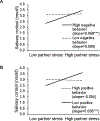Cortisol slopes and conflict: A spouse's perceived stress matters
- PMID: 32853875
- PMCID: PMC7572803
- DOI: 10.1016/j.psyneuen.2020.104839
Cortisol slopes and conflict: A spouse's perceived stress matters
Abstract
Background: Perceived stress can lead to dysregulated cortisol patterns, including blunted peaks and flatter slopes, which are associated with increased morbidity and mortality risks. Couples' interdependence provides a prime opportunity for partners' stress to disrupt a healthy cortisol pattern. This study examined how individuals' own perceived stress and their partners' perceived stress shape cortisol levels and slopes across the day, as well as how positive and negative behaviors during conflict discussions impact associations between stress and cortisol.
Methods: Both partners of a married couple (n = 43 couples, 86 individuals) completed a full day in-person visit. Each partner completed the Perceived Stress Scale, and all couples engaged in a 20-min marital problem discussion which was recorded and later coded for positive and negative behaviors using the Rapid Marital Interaction Coding System (RMICS). Partners also provided five salivary cortisol samples across the day, two samples before the conflict and three after the conflict. The dyadic design and analyses provided a way to account for the interdependent nature of married couples' data, as well as to use the Actor-Partner Interdependence Model (APIM) to assess the mutual influence of spouses' stress on cortisol.
Results: Individuals with more stressed partners had flatter cortisol slopes than individuals with less stressed partners, who showed steeper and thus healthier declines across the day. Individuals' cortisol levels at the beginning of the day were similar regardless of their partners' perceived stress, but individuals with more stressed partners had higher cortisol levels 30-min, 1 h, and 4 h after the conflict discussion than those with less stressed partners. Couples' behavior during the conflict moderated the relationship between partner perceived stress and average cortisol; when couples used more negative and less positive behaviors, individuals with more stressed partners had higher average cortisol levels than those with less stressed partners.
Conclusion: On a day couples experienced conflict, having a partner with higher perceived stress is associated with dysregulated cortisol patterns, including higher levels and flatter slopes, but having a partner with lower perceived stress is linked to steeper and thus healthier cortisol declines. A partner's stress was particularly consequential for one's own cortisol when couples used more negative and fewer positive behaviors during a conflict discussion. This research adds to the growing literature on pathways connecting marital interactions to important biorhythms and health.
Keywords: Conflict; Cortisol; Health; Marriage; Romantic relationships; Stress.
Copyright © 2020. Published by Elsevier Ltd.
Conflict of interest statement
The authors have no conflict of interest to report.
Figures


Similar articles
-
For better or worse? Coregulation of couples' cortisol levels and mood states.J Pers Soc Psychol. 2010 Jan;98(1):92-103. doi: 10.1037/a0016959. J Pers Soc Psychol. 2010. PMID: 20053034
-
HPA regulation and dating couples' behaviors during conflict: gender-specific associations and cross-partner interactions.Physiol Behav. 2013 Jun 13;118:218-26. doi: 10.1016/j.physbeh.2013.05.037. Epub 2013 May 24. Physiol Behav. 2013. PMID: 23711564 Free PMC article.
-
Spouses' attachment pairings predict neuroendocrine, behavioral, and psychological responses to marital conflict.J Pers Soc Psychol. 2013 Sep;105(3):388-424. doi: 10.1037/a0033056. Epub 2013 Jun 17. J Pers Soc Psychol. 2013. PMID: 23773048 Free PMC article.
-
Lovesick: How Couples' Relationships Influence Health.Annu Rev Clin Psychol. 2017 May 8;13:421-443. doi: 10.1146/annurev-clinpsy-032816-045111. Epub 2017 Mar 16. Annu Rev Clin Psychol. 2017. PMID: 28301763 Free PMC article. Review.
-
What Factors are Associated with Sexual Satisfaction, Distress, and Function in Couples? A Systematic Scoping Review of Dyadic Diary Studies.J Sex Res. 2025 Apr 10:1-18. doi: 10.1080/00224499.2025.2486475. Online ahead of print. J Sex Res. 2025. PMID: 40208220 Review.
Cited by
-
Dyadic loneliness, age, and cognitive functioning among midlife and older Black couples.Aging Ment Health. 2024 Jun;28(6):882-890. doi: 10.1080/13607863.2023.2288862. Epub 2023 Dec 4. Aging Ment Health. 2024. PMID: 38047614 Free PMC article.
-
Minimal couple intervention to improve psychobiological stress resilience.Br J Health Psychol. 2025 May;30(2):e12799. doi: 10.1111/bjhp.12799. Br J Health Psychol. 2025. PMID: 40356464 Free PMC article. Clinical Trial.
-
How aging couples' emotional and physiological associations change across positive, supportive, and conflictual discussions: Roles of capitalization and responsive behaviors.Biol Psychol. 2023 Feb;177:108500. doi: 10.1016/j.biopsycho.2023.108500. Epub 2023 Jan 13. Biol Psychol. 2023. PMID: 36646301 Free PMC article.
-
Couples in breast cancer survivorship: Daily associations in relationship satisfaction, stress, and health.Compr Psychoneuroendocrinol. 2024 Aug 19;20:100261. doi: 10.1016/j.cpnec.2024.100261. eCollection 2024 Nov. Compr Psychoneuroendocrinol. 2024. PMID: 39281968 Free PMC article.
-
"I'm Ready This Time": Investigating physiological and emotional habituation to repetitive social stress.Ann Behav Med. 2025 Jan 4;59(1):kaaf009. doi: 10.1093/abm/kaaf009. Ann Behav Med. 2025. PMID: 40036285
References
-
- Aiken LS, West SG, 1991. Multiple regression: Testing and interpreting interactions., Multiple regression: Testing and interpreting interactions. Sage Publications, Inc, Thousand Oaks, CA, US.
-
- Cohen S, Kamarck T, Mermelstein R, 1983. A global measure of perceived stress. J. Health Soc. Behav 24, 385–396. - PubMed
Publication types
MeSH terms
Substances
Grants and funding
LinkOut - more resources
Full Text Sources
Medical

